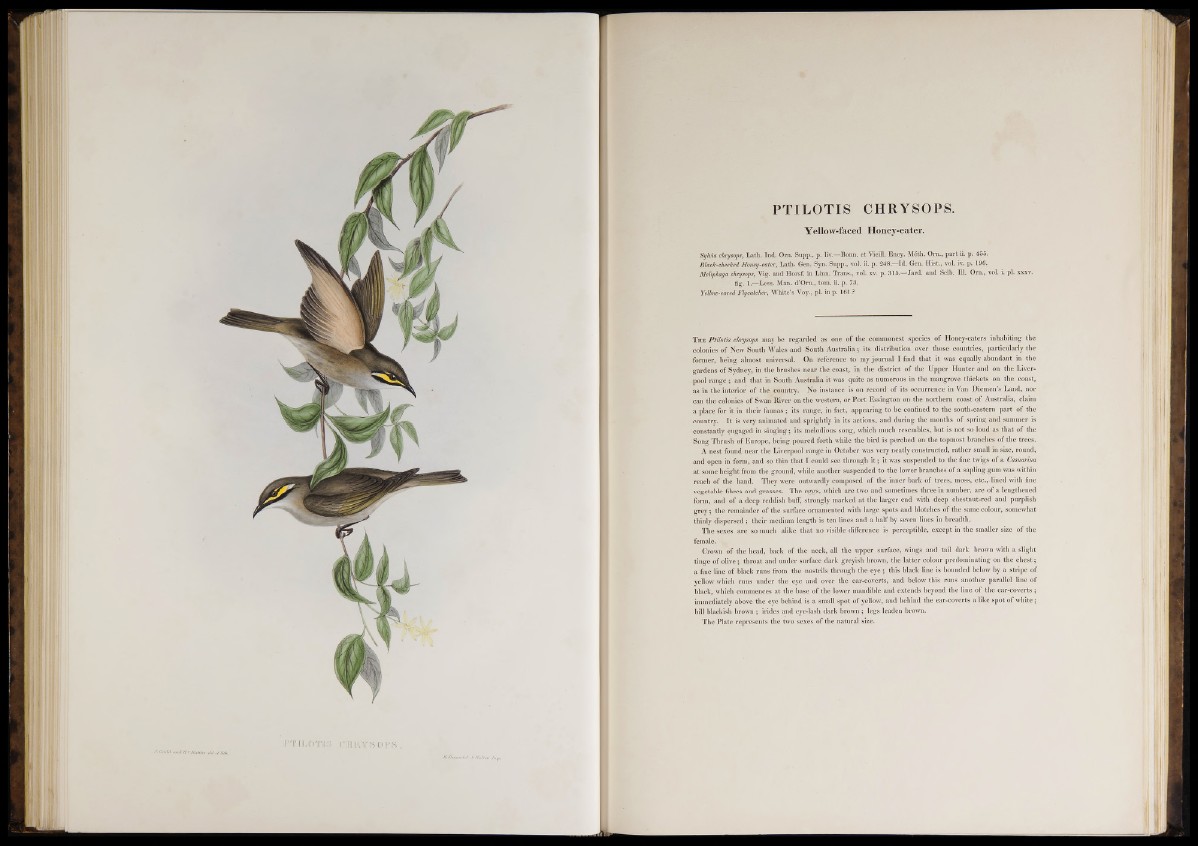
PTILOTIS CHRYSOPS.
Yellow-faced Honey-eater.
Sylvia chrysops, Lath. Ind. Om. Supp., p. liv.—Bonn, et Vieill. Ency. Metli. Orn., part ii. p. 455.
Black-cheeked Honey-eater, Lath. Gen. Syn. Supp., vol. ii. p. 248.—Id. Gen. Hist., vol. iv. p. 196.
Meliphaga chrysops, Vig. and Horsf. in Linn. Trans., vol. xv. p. 315.—Jard. and Selb. 111. Orn., vol. i. pi. xxxv.
fig. 1.—Less. Man. d’Orn., tom. ii. p. 73.
Yellow-eared Flycatcher, White’s Voy., pi. in p. 161 ?
T h e Ptilotis chrysops may be regarded as one of the commonest species o f Honey-eaters inhabiting the
colonies of New South Wales and South Australia; its distribution over those countries, particularly the
former, being almost universal. On reference to my journal I find that it was equally abundant in the
gardens of Sydney, in the brushes near the coast, in the district o f the Upper Hunter and on the Liverpool
range ; and that in South Australia it was quite as numerous in the mangrove thickets on the coast,
as in the interior of the country. No instance is on record of its occurrence in Van Diemen’s Land, nor
can the colonies of Swan River on the western, or Port Essington on the northern coast of Australia, claim
a place for it in their faunas ; its range, in fact, appearing to be confined to the south-eastern part of the
country. It is very animated and sprightly in its actions, and during the months of spring and summer is
constantly engaged in singing; its melodious song, which much resembles, but is not so loud as that of the
Song Thrush of Europe, being poured forth while the bird is perched on the topmost branches of the trees.
A nest found near the Liverpool range in October was very neatly constructed, rather small in size, round,
and open in form, and so thin that I could see through i t ; it was suspended to the fine twigs of a Casuarina
at some height from the ground, while another suspended to the lower branches of a sapling gum was within
reach of the hand. They were outwardly composed o f the inner bark of trees, moss, etc.,.lined with fine
vegetable fibres and grasses. The eggs, which are two and sometimes three in number, are of a lengthened
form, and of a deep reddish buff, strongly marked at the larger end with deep chestnut-red and purplish
grey; the remainder o f the surface ornamented with large spots and blotches of the same colour, somewhat
thinly dispersed; their medium length is ten lines and a half by seven lines in breadth.
The sexes are so much alike that no visible difference is perceptible, except in the smaller size of the
female.
Crown of the head, back of the neck, all the upper surface, wings and tail dark brown with a slight
tinge of olive; throat and under surface dark greyish brown, the latter colour predominating on the chest;
a fine line of black runs from the nostrils through the e y e ; this black line is bounded below by a stripe of
yellow which runs under the eye and over the ear-coverts, and below this runs another parallel line o f
black, which commences at the base of the lower mandible and extends beyond the line of the ear-coverts ;
immediately above the eye behind is a small spot of yellow, and behind the ear-coverts a like spot o f white;
bill blackish brown ; irides and eye-lash dark brown ; legs leaden brown.
The Plate represents the two sexes of the natural size.